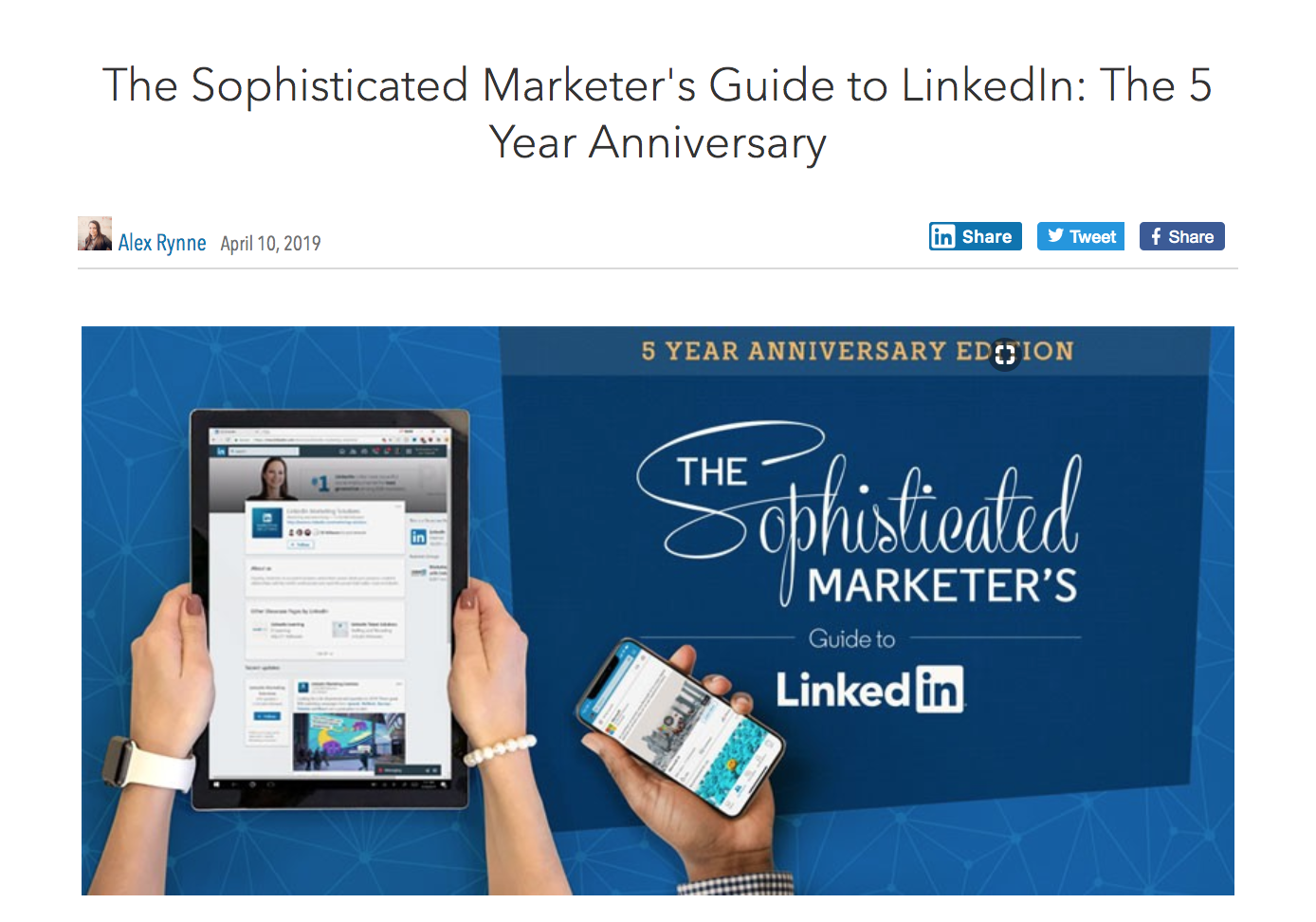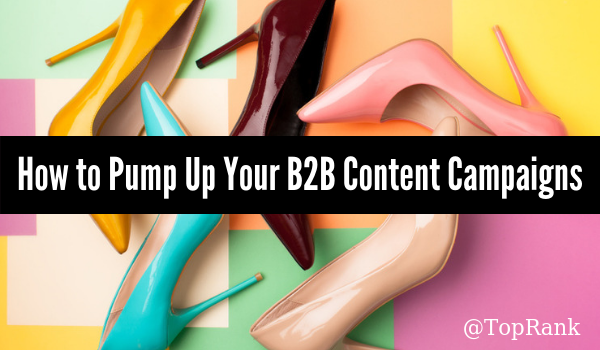
Let’s talk shoes for a moment. Years ago, I purchased a stunning pair Jimmy Choo stiletto pumps; they were all the rage at that time. I’d been eyeing them for months and I convinced myself that this rather spendy investment would pay dividends in style and wearability.
When my Choos made their public debut, I was showered with compliments on how gorgeous they were. I was feeling great.
Of course, a few hours later a shooting pain in my Achilles tendon meant it was time to give them a rest, so I changed into tennis shoes.
Today, those shoes are collecting dust in my closet. And every time I see them, I feel a mixture of regret (perhaps not my wisest investment after all) and longing to take them out for another spin (with the right insoles at a sitting event).
B2B marketers are making huge investments in content this year, and that trend will only continue. From what we’re seeing across the industry, many marketers are investing in splashy content marketing campaigns. But like my Jimmy Choos, after the initial thrill and luster subsides, campaign content can start collecting dust at the back of the resource center and you may even wonder if it was worth the investment.
The good news is, with the right insight and planning you can regret-proof you campaigns. Taking the time to ensure the right messaging, promotional strategy, and long-term opportunities can help you extend the life span and visibility of your campaigns and drive results that are meaningful to your team and brand.
Here are five key considerations to help you do just that.
How to Maximize Your B2B Content Marketing Campaign Investment
#1 – Nail the hook.
This first step may be the trickiest, but it’s critical to build the foundation for a successful campaign. Creating a campaign hook that will inspire your target audience to engage, share, and talk about and remember your brand is both art and science.
Creating a campaign hook that will inspire your target audience to engage, share, and talk about and remember your brand is both art and science. @Alexis5484 #B2BContentMarketing Click To TweetLet’s start with the science. In short, go with the data.
Who is your ideal customer or prospect? Not just their job title and company size, but rather what problems are they trying to solve? Who do they trust? What are they interested in aside from doing their job? Where do they spend their time online?
Leverage both quantitative and qualitative sources to bring this data together. Talk to your sales team or customer service reps since they are typically the most connected to your prospects and current customers. Engage in social media listening. Gather third party data. Perhaps consider creating your own data by designing and deploying a customer or industry survey.
Then run the data you collect through the business lens. How do you solve your customers’ problems? What key features or benefits are deserving of more attention? What types of content (e.g. webinars, white papers, interactive infographics) can you create to garner the most attention and interest? And finally, how can you bring everything together under a creative umbrella for maximum resonance?
This is where the art piece comes in. Tap into your best listeners, creative thinkers, and strategizers to finalize a theme and key messages that you believe will connect with and move your target audience.
Now, this piece of advice can be key to testing the viability of your content hook both short- and long-term. Do some acid testing. Ask your network for their initial thoughts or run a few A/B tests on social media to see if your hook is resonating. You’re not just looking for thumbs up. You’re looking for messaging that is memorable, creates brand affinity, and propels the user to take action.
#2 – Make promotion part of the planning process so you’re ready for launch day and beyond.
Your team has put a lot of effort into building your campaign. But far too often, promotion is an afterthought rather than an integral part of the planning and strategy process. This ensures integration from the beginning, minimizes stress as you draw closer to launch day, and allows you to think more globally about how you can promote or repurpose into the future.
Content promotion can’t be effective if it’s an afterthought. Your best practice would be to make promotion part of content planning. - @leeodden Click To TweetAs you draw closer to launch, create a promotional timeline that includes your tactical mix and content types. Ideally, that timeline will be at least three months in length. This will help you prevent a campaign from flaming out after two weeks of heavy promotion.
Your promotional timeline and plan could include:
- Adding crosslinks and/or banner CTAs across your website or blog
- Emails to customers and prospects
- Social media messages, images, and video across major channels
- A paid social targeting plan
- Press releases or other third-party editorial
- Repurposing plans (which we’ll get to in the next section)
Of course, when launch day arrives, the real work begins. Day 1 promotion is important to gaining campaign buzz, so plan to get all your promotion engines firing. But perhaps the most important piece of building out that promotional timeline is creating a cadence; tactics can be used beyond Day 1 or Week 1. (e.g. Just because you sent an email or press release on Day 1, doesn’t mean you can’t again on Day 7, Day 14, or Day 30.)
For more insight on designing your promotional timeline, check out these 50 content promotion tactics.
#3 – Optimize … and repromote.
Since you did so much research and planning upfront, hopefully your message is resonating and you’re seeing great results one, two, three, or even four weeks out. But whether you’re meeting, exceeding, or falling short of your expectations, post-launch is the time to really maximize your investment.
At launch, establish a regular check-in cadence with your team to review results and discuss campaign optimization opportunities. This is not the time to sit back and just watch the results roll in. You can start optimizing campaign performance on Day 1.
There are two key areas to focus on during your check-ins:
- Reach: Are you reaching your goals in terms of visibility? If not, you may need to look at additional channels (e.g. third party editorial) or adjust your paid investment (if you haven’t already). In addition, look at what channels are driving the most visibility and put more investment there.
- Engagement: This is a time to review what messages, visuals, and channels are driving the most people to take action. If certain messaging isn’t working, swap it out. Take a look at the bounce rate, conversion rate, and time spent on your landing page. This is usually a prime place to make adjustments.
Optimization will help you throughout the course of the campaign to learn from what is working and make adjustments to ensure more reach and engagement (and less regret) throughout.
#4 – Repurpose … and repromote.
Every brand is sitting on a dust-collecting gold mine of content. Whether you’re launching a brand new campaign or you’re trying to resurrect (or reimagine) one from a months or years past, this consideration has unending relevance and applications. Also, if the above mentioned recommendation to create a three-month promotion production timeline felt too long, you may not have been thinking about repurposing opportunities.
Here are a couple repurposing scenarios for your consideration:
Repurpose to extend the life of your campaign.
In this scenario you’re repurposing elements of an active campaign to drive back to your primary content hub. An easy way to repurpose content is to change up the format type.
For example, pull out nuggets from a text based eBook and create a video for social media or YouTube to drive back to the original asset. If your content was audio or video, pull quotes and create a series of text based blogs driving back to the main asset. A new infographic, motion graphic, or blog content is a good reason to re-promote, remind your existing audience, and reach new prospects.
Repurpose to create your next campaign.
Even after the lifespan of a campaign is mostly over, that campaign investment can absolutely be leveraged for a future campaign. You can create an entirely new campaigns by bringing together previous content from other campaigns, blog posts, and influencer contributions. It can also work really well to freshen up an evergreen piece and re-release with new information.
Here’s a recent example from *LinkedIn. The Sophisticated Marketer’s Guide to LinkedIn was a cornerstone campaign a few years back, and a helpful asset that had long-term appeal. And in honor of its fifth anniversary, the content and design was refreshed, re-released, and repromoted.

Bonus tip: In order to be really effective at repurposing content, it really helps to have some kind of searchable repository of all the content that has been created organized by topic. Your website isn’t always the most reliable or complete source of content created.
Read: A Tasty, Strategic Addition to the Content Marketing Table: ‘Repurposed Content Cobbler’
#5 – Integrate your B2B content marketing campaigns with your always-on strategy.
If you really want to maximize your B2B content marketing campaigns, you have to think long-term. Campaigns work hand-in-hand with your ongoing, always-on marketing efforts.
Ultimately, your marketing efforts aim to fill the funnel, foster brand affinity, and achieve business ROI. If you design campaigns that fit within your core objectives, strategy, and marketing pillars, then they’ll always be a make-sense investment.
In addition, integrating you campaigns within your always-on strategy can help you enhance your nurturing capabilities as they relate to your customers, prospects, and target audience, as well as influencers, by creating an interesting, steady drumbeat of content. It also makes repurposing easier and helps extend and keep conversations top-of-mind.
Pump Your B2B Content Marketing Campaigns Up
Flashy, attention-grabbing campaigns can be great investments. They can drive valuable spikes in traffic, engagement, or conversions, as well as help you target specific audiences or verticals.
However, without an eye toward the long-term, campaigns often end up like my beautiful Jimmy Choo pumps: A wasted investment that’s collecting dust.
By spending time upfront to thoughtfully identify your creative hook and robust, longer-than-a-few-weeks promotional strategy, you can continue to promote and optimize your campaign content for maximum impact and ROI.
Are you notching some serious big wins on a recent campaign? How do you keep that momentum going? How do you apply your learnings to what comes next? Check out my post on driving continuous content marketing improvement.
*Disclosure: LinkedIn is a TopRank Marketing client.



